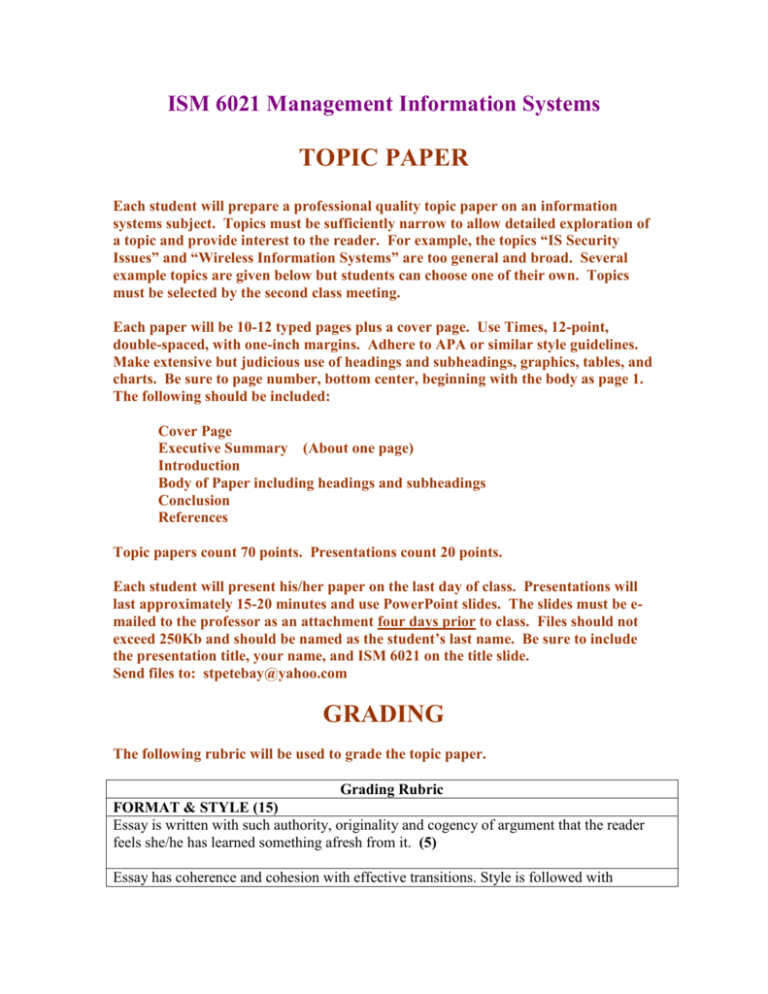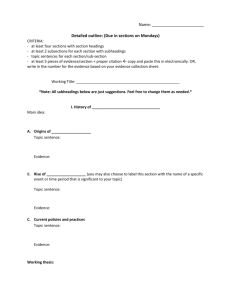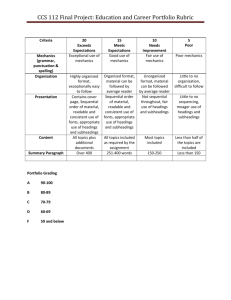ISM 6021 Management Information Systems
advertisement

ISM 6021 Management Information Systems TOPIC PAPER Each student will prepare a professional quality topic paper on an information systems subject. Topics must be sufficiently narrow to allow detailed exploration of a topic and provide interest to the reader. For example, the topics “IS Security Issues” and “Wireless Information Systems” are too general and broad. Several example topics are given below but students can choose one of their own. Topics must be selected by the second class meeting. Each paper will be 10-12 typed pages plus a cover page. Use Times, 12-point, double-spaced, with one-inch margins. Adhere to APA or similar style guidelines. Make extensive but judicious use of headings and subheadings, graphics, tables, and charts. Be sure to page number, bottom center, beginning with the body as page 1. The following should be included: Cover Page Executive Summary (About one page) Introduction Body of Paper including headings and subheadings Conclusion References Topic papers count 70 points. Presentations count 20 points. Each student will present his/her paper on the last day of class. Presentations will last approximately 15-20 minutes and use PowerPoint slides. The slides must be emailed to the professor as an attachment four days prior to class. Files should not exceed 250Kb and should be named as the student’s last name. Be sure to include the presentation title, your name, and ISM 6021 on the title slide. Send files to: stpetebay@yahoo.com GRADING The following rubric will be used to grade the topic paper. Grading Rubric FORMAT & STYLE (15) Essay is written with such authority, originality and cogency of argument that the reader feels she/he has learned something afresh from it. (5) Essay has coherence and cohesion with effective transitions. Style is followed with consistency. (5) Essay is perfect with respect to grammar, style and spelling. (5) CONTENT (55) Treatment was balanced as to allow sufficient coverage and provides the reader with a complete understanding of the topical area. Content matched the title. Material was correct and relevant. Length met minimum criteria. Level of material met standard for an MIS class. (14) Knowledge was delineated with lucidity, elegance and comprehensiveness. (5) The essay contained a complete cover page and page numbers. (4) The essay adhered to the assigned topic without digressing. (4) The story was sequenced in such an order as to promote understanding. (4) The paper made effective use of tables and diagrams. (4) An effective Executive Summary was provided. (4) An effective Introduction was provided. (3) An effective Conclusions was provided. (3) Headings and subheadings were used effectively to promote understanding. (4) References were sufficient and appropriate. Citations were made to the references. (6) The following rubric will be used to grade the topic paper presentation. Topic Paper Presentation (20 Points) The total points will be multiplied by .20. SLIDES (20) Easy to read. Support the presentation with clarity and comprehension. Correct sequencing. (10) Slides are business-like in appearance. (10) CONTENT (50) The material provided a good understanding of the subject. (35) The material was interesting and informative. (15) PRESENTATION (30) The presentation was professional. Attention was given to the subject without unnecessary hesitation or digressions. (20) Direct eye contact without looking back at slides frequently. (5) Presenter was not nervous, did not display mannerisms, used business language, was appropriately attired. (5) SAMPLE TOPICS The following topics are suggestions only. Students may wish to develop their own topic with the approval of the professor. Be sure that the topic is sufficiently defined to warrant investigation. Telemedicine and IT (Dennis – See papers) Facilitators & Inhibitors to Using Rapid Application Development Implementing Security for Wireless Systems (Martha) Using Intranets for Knowledge Management (Diana) IT in the Construction Industry (John) Knowledge Management: The Problem of Organizing Data Measuring the Success of E-Commerce Sites Evaluating Investments in Information Technology (Shannon) Implementing IT Strategies Aligning the Strategic IS Plan with the Business Plan The Importance of Shared Domain Knowledge to the Effective Use of IT Capturing Tacit Knowledge for Organizational Learning (Vanessa) Updated Oct 22, 2002 by GS Kearns








